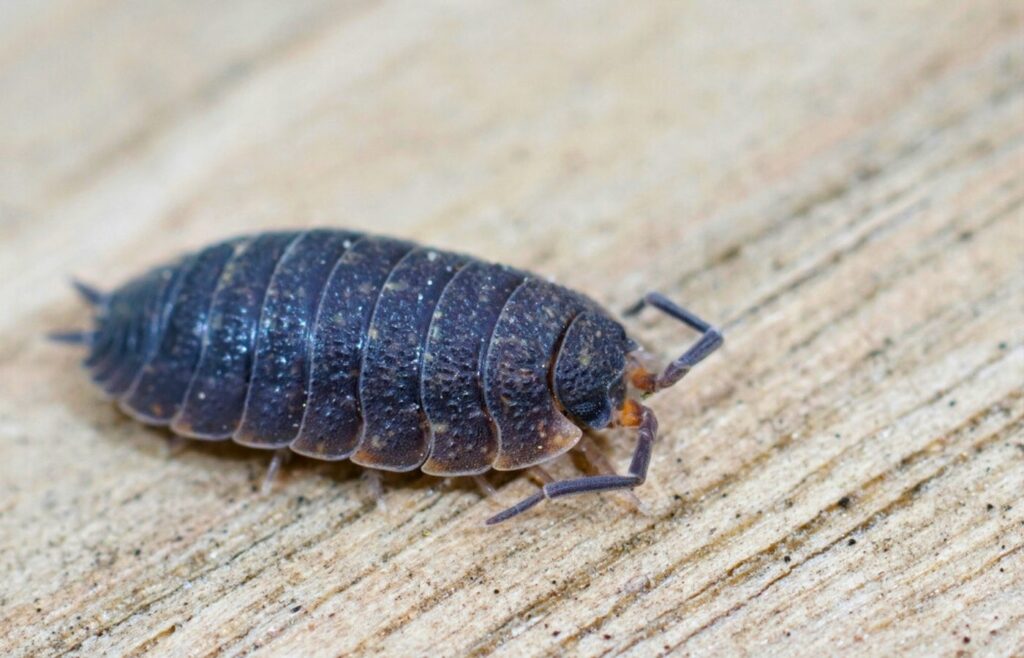Have you recently noticed small gray creatures in certain dark or damp areas of your home, particularly in the basement, cellar, or under the sink? You are likely dealing with woodlice.
But don’t worry: these creatures, although invasive, pose no danger to humans. Here’s how to recognize them, understand their presence, and, most importantly, how to easily get rid of them.
Quick portrait of woodlice: who are they exactly?
Contrary to popular belief, woodlice (Oniscus asellus) are not insects but small terrestrial crustaceans. Did you know that there are over 4,000 different species worldwide? In France, approximately 220 species can be found.
The common woodlice is recognizable by its oval shape and dark color (black, gray, or dark brown). It measures between 13 and 18 millimeters long, has a rigid shell, and can roll into a ball when threatened.
These small crustaceans breathe through gills and have 7 pairs of legs and two pairs of antennae. They prefer to live in cool, damp places where they primarily feed on decaying plant debris. They also don’t mind nibbling on dead insects or overly ripe fruits within reach.
Where do we find woodlice?
In nature, you can easily spot them:
- under stones and flower pots
- in compost
- in decaying wood
- in damp foliage or mushrooms
They play a valuable role in speeding up the decomposition of plant materials and contribute to the proper functioning of ecosystems.
Why do woodlice invade your home?
Noticed a real invasion in your home? Woodlice particularly enjoy dark and damp places. Therefore, they love:
- basements and cellars
- poorly insulated garages
- under sinks
- attics
- any cracks or small openings that allow easy access to your home
Their appearance may be a revealing sign of certain domestic issues such as:
- water leaks or infiltration in walls or roofs
- poor ventilation or insulation
- excessive humidity in certain rooms
- the presence of mold or organic waste available to them
Also, be attentive to other signs: slightly gnawed wooden furniture or square droppings near their gathering spots.
Our practical tips to effectively deter woodlice
If you’re facing a woodlice invasion, there’s no need to use chemical products. Instead, follow these simple and eco-friendly tips:
Combat humidity
Eliminating humidity is essential to prevent their proliferation:
- Regularly ventilate all your rooms, especially basements and cellars.
- Consider using a dehumidifier or plants like Tillandsia and spider plants, known for absorbing ambient moisture.
- Monitor and promptly repair any water leaks with the help of a qualified professional.
Seal exterior accesses
Regularly inspect facades, openings, window joints, doors, grills, and ventilation ducts. Seal any cracks or small openings with appropriate mortar or sealant.
Maintain your exteriors
Keep flower pots and organic waste away from the base of exterior walls. Regularly clean gutters to prevent woodlice from settling in them.
Manage your household waste
Adopt sealed trash bins, especially during warmer periods. Remember to regularly empty your food waste to eliminate food sources that attract woodlice.
Implement natural repellents
Some essential oils are very effective: apply a few drops of neem essential oil diluted in strategic areas of your home.
Diatomaceous earth, sprinkled around baseboards and passageways, is also very effective for naturally repelling these little creatures.
Install ecological traps
Finally, a piece of moist wood left in place overnight will attract them. Simply dispose of this makeshift trap the next day, ideally near your compost.
If you’ve implemented all these tips but still notice the persistent presence of woodlice, then consider calling in a pest control specialist for a targeted intervention.
Have you encountered woodlice issues at home? What solutions have you tried? Share your experience and tips with us in the comments below. Your feedback could help other readers!

